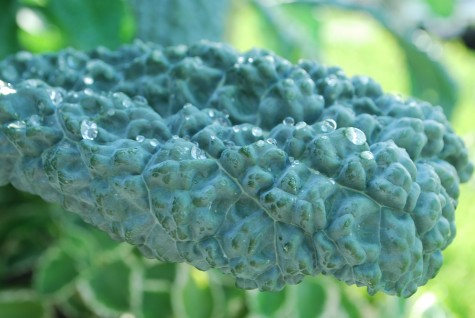 The big blue tuscan kale I know as Nero di Toscano is a favorite plant. The giant blistered blue-green leaves have that vaguely prehistoric look to them. The common name, dinosaur kale, aptly describes this massive growing, highly textured plant. As with any member of the brassica family, they are beloved by chewing insects. It is a rare cabbage or kale whose leaves do not bear holes and chomp marks.
The big blue tuscan kale I know as Nero di Toscano is a favorite plant. The giant blistered blue-green leaves have that vaguely prehistoric look to them. The common name, dinosaur kale, aptly describes this massive growing, highly textured plant. As with any member of the brassica family, they are beloved by chewing insects. It is a rare cabbage or kale whose leaves do not bear holes and chomp marks.
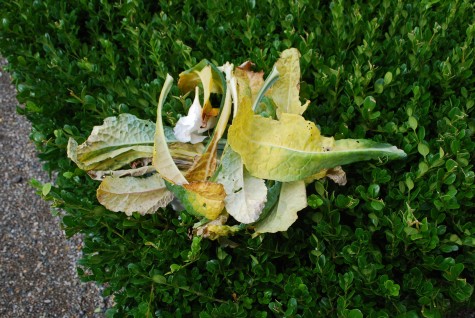 The lower leaves mature in a spectacularly unattractive way. Some ornamental cabbages are grown for the cut flower trade; a long thick stem will have a tuft of brightly colored or white leaves sitting on top. All plants have characteristics that are less than desirable. Annabelle hydrangeas are weak stemmed, and flop over the minute they are in full bloom. The roses get blackspot; post-bloom maturing foliage on daylilies is nasty looking. Designing with plants is much about pairing them with other plants that minimize those faults. I would not give up growing kale over their legs.
The lower leaves mature in a spectacularly unattractive way. Some ornamental cabbages are grown for the cut flower trade; a long thick stem will have a tuft of brightly colored or white leaves sitting on top. All plants have characteristics that are less than desirable. Annabelle hydrangeas are weak stemmed, and flop over the minute they are in full bloom. The roses get blackspot; post-bloom maturing foliage on daylilies is nasty looking. Designing with plants is much about pairing them with other plants that minimize those faults. I would not give up growing kale over their legs.
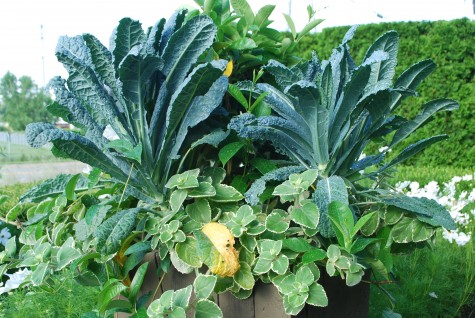 I planted the pots in front of the shop this year with the aforementioned kale, green and white variegated plectranthus, and sun parasol white mandevillea. I thought the three planted together would make for some interesting conversation. This plectranthus is lax growing. The thick stems will droop under their own weight. They grow vigorously-in this case, they are growing vigorously around the kale that are loosing their lower leaves. Their trailing habit makes them the perfect cover-up for those awkwardly leggy and stiff growing kale.
I planted the pots in front of the shop this year with the aforementioned kale, green and white variegated plectranthus, and sun parasol white mandevillea. I thought the three planted together would make for some interesting conversation. This plectranthus is lax growing. The thick stems will droop under their own weight. They grow vigorously-in this case, they are growing vigorously around the kale that are loosing their lower leaves. Their trailing habit makes them the perfect cover-up for those awkwardly leggy and stiff growing kale.
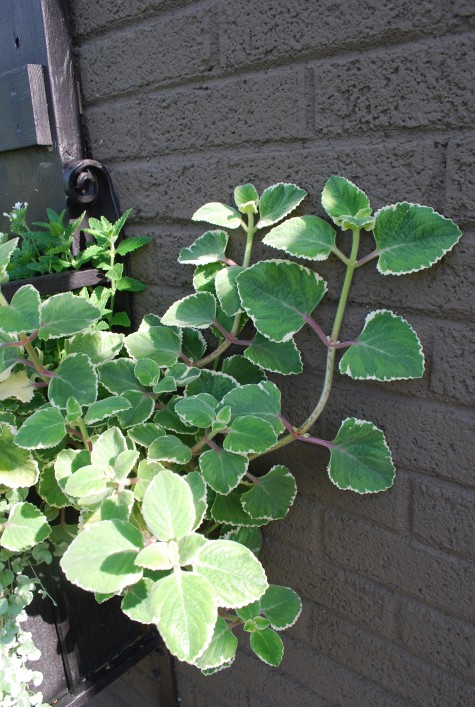 Related to coleus, they do respond to pinching back, but once the weather gets hot, they grow with huge stem spaces between the leaves. This puts them on the verge of becoming a vining plant. This does however take time. They are great for a gardener that likes to watch things grow. These pots in their infancy were not all that great looking. I avoided looking at them all together for the first month after they were planted.
Related to coleus, they do respond to pinching back, but once the weather gets hot, they grow with huge stem spaces between the leaves. This puts them on the verge of becoming a vining plant. This does however take time. They are great for a gardener that likes to watch things grow. These pots in their infancy were not all that great looking. I avoided looking at them all together for the first month after they were planted.
 These concrete pots are quite tall, and have a smaller planting area that what I would like. Though they have a graceful presence as an object, it is not easy to grow something in them large enough to balance all that pot height. I think this planting is my best shot ever at getting a finished proportion that is right. We have had such a warm and rainy growing season this year that the pots are already rootbound. Maintaining these another few months will be a challenge. I need more horizontal volume from that plectranthus-judicious pinching back is in order.
These concrete pots are quite tall, and have a smaller planting area that what I would like. Though they have a graceful presence as an object, it is not easy to grow something in them large enough to balance all that pot height. I think this planting is my best shot ever at getting a finished proportion that is right. We have had such a warm and rainy growing season this year that the pots are already rootbound. Maintaining these another few months will be a challenge. I need more horizontal volume from that plectranthus-judicious pinching back is in order.
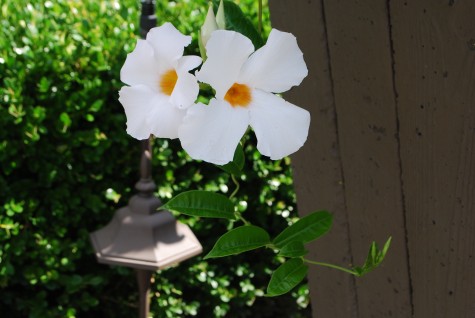 The third party at the table, the white mandevillea, is a tropical vine that doens’t begin to get going until the weather gets really hot. This plant did not perform particularly well last summer, as the weather stayed cool. The Sun Parasol series is known for its glossy and disease resistant foliage. The red cultivar is particularly heavy blooming. My experience with other varieties, such as Alice de Pont-spider mites and mildew rule the day. No thank you. Though this plant is a vine, I decided to grow it as a trailer, and let the chips fall where they might. One never knows what a plant will do, left to its own devices.
The third party at the table, the white mandevillea, is a tropical vine that doens’t begin to get going until the weather gets really hot. This plant did not perform particularly well last summer, as the weather stayed cool. The Sun Parasol series is known for its glossy and disease resistant foliage. The red cultivar is particularly heavy blooming. My experience with other varieties, such as Alice de Pont-spider mites and mildew rule the day. No thank you. Though this plant is a vine, I decided to grow it as a trailer, and let the chips fall where they might. One never knows what a plant will do, left to its own devices.
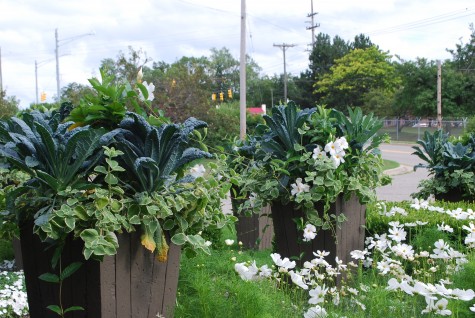 Early on, I was worried this might have been a mistake. The pots looked ungainly, underscaled, and ill-defined. But plants seek the sun, and live companionably with other plants. Most of the plants on this earth manage to live and prosper without much help from people. The three plants in these pots share one characterisitc-they are all vigorous growers. The battle they do for light and water is creating the overall shape you see. They share the light and water as they are fairly equally matched. The large mandevillea flowers help cover the leggy kale as much as the plectrathus does. The mandevillea gets support from the stiff stems of the plectranthus.
Early on, I was worried this might have been a mistake. The pots looked ungainly, underscaled, and ill-defined. But plants seek the sun, and live companionably with other plants. Most of the plants on this earth manage to live and prosper without much help from people. The three plants in these pots share one characterisitc-they are all vigorous growers. The battle they do for light and water is creating the overall shape you see. They share the light and water as they are fairly equally matched. The large mandevillea flowers help cover the leggy kale as much as the plectrathus does. The mandevillea gets support from the stiff stems of the plectranthus.
 These tall pots are finally beginning to look like something. The combination is to my eye more interesting than any of the individual plants. Growing mandevillea as a trailer, and plectranthus as a climber and a kale for some other purpose than braising is what makes gardening so interesting. Whenever I visit a garden or a landscape, a good deal of what I see is that conversation between the gardener and the natural world. Is there an interesting conversation going on? Is one of the involved parties talking too much, or not enough?
These tall pots are finally beginning to look like something. The combination is to my eye more interesting than any of the individual plants. Growing mandevillea as a trailer, and plectranthus as a climber and a kale for some other purpose than braising is what makes gardening so interesting. Whenever I visit a garden or a landscape, a good deal of what I see is that conversation between the gardener and the natural world. Is there an interesting conversation going on? Is one of the involved parties talking too much, or not enough?
 I am hoping these containers are a little better than half-way to being good. Should they never get really good-fine. There will be something about the experiment that will help make me a more interesting gardener.
I am hoping these containers are a little better than half-way to being good. Should they never get really good-fine. There will be something about the experiment that will help make me a more interesting gardener.